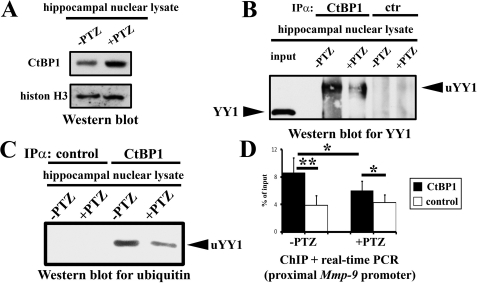FIGURE 8.
Neuronal depolarization leads to a reduction of CtBP1/YY1 interaction in vitro and triggers CtBP1 dissociation from the proximal Mmp-9 promoter in vivo in the cell nuclei of the rat hippocampus. A, CtBP1 is expressed in cell nuclei of the rat hippocampal cells and up-regulated after PTZ-induced seizures. Equal amounts (20 μg) of nuclear cell lysates obtained from the unstimulated (-PTZ) as well as from the PTZ-stimulated (2 h; +PTZ) rat hippocampi were analyzed by Western blot with anti-CtBP1 antibody. As a loading control, results of Western blot analysis for histone H3 are shown. B, CtBP1 physically interacts with YY1 in a depolarization-dependent manner in cell nuclei of the rat hippocampus. Equal amounts (300 μg) of nuclear cell lysates obtained from the unstimulated (-PTZ) as well as from the PTZ-stimulated (2 h; +PTZ) rat hippocampi were immunoprecipitated (IPα) with anti-CtBP1 or control (isotype) antibody and analyzed for YY1 expression by Western blot. As a positive control, protein nuclear cell lysate obtained from the unstimulated hippocampi has been used (resolved in the input lane). Unmodified YY1 (YY1) and its ubiquitinated form (uYY1) are indicated. C, interaction of CtBP1 with ubiquitinated YY1 is neuronal activity-dependent in cell nuclei of the rat hippocampus. Equal amounts (300 μg) of nuclear cell lysates obtained from the unstimulated (-PTZ) as well as from the PTZ-stimulated (2 h; +PTZ) rat hippocampi were immunoprecipitated with anti-CtBP1 or control (isotype) antibody and analyzed for ubiquitin expression by Western blot. The ubiquitinated YY1 (uYY1) is indicated. D, CtBP1 occupies the proximal Mmp-9 promoter in the unstimulated hippocampus and is released after PTZ-evoked neuronal depolarization. Evaluation by real time PCR of the proximal Mmp-9 promoter content in DNA samples obtained because of immunoprecipitation of chromatin bound to CtBP1 from the unstimulated (-PTZ) as well as from the PTZ-stimulated (2 h; +PTZ) rat hippocampi. Control ChIP reactions were performed with isotype antibody. Error bars represent the mean ± S.D. (n = 3; *, p < 0.05; **, p < 0.01).

